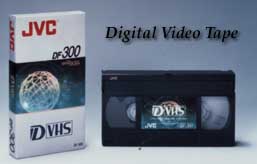VHS Goes Digital!
JVC Introduces the DF-300 D-VHS Cassette

New York, NY, June 19, 1997 . . . JVC, inventor of the VHS format, proudly announces a new addition to its extensive videotape line-up - the DF-300. While retaining compatibility with existing VHS equipment, this D-VHS cassette has been developed specifically for digital recording and offers the highest level of data integrity.
The D-VHS cassette can be used for recording the analog video signals of current TV broadcasting (NTSC, PAL, etc.), so it maintains continuity with the vast VHS-based video archives that exist in businesses and homes throughout the world. Quality is equivalent to that of a top-grade S-VHS videotape. It is also compatible with bitstream technology, thus enabling time-shift recording of digital broadcasts. Yet it is in no way limited to video applications. The worldwide shift from analog to digital technology has heightened the demand for reliable, high-capacity storage - a field in which tape media has a proven track record. JVC�s new D-VHS cassette can be used for recording virtually any digital information, making it the perfect choice for multimedia applications.
Key to the high performance of this D-VHS cassette is an ultra-low error rate, which JVC has achieved with three new developments in tape technology.
Ultra-fine D-Magnetite magnetic particles
The material forming the magnetic layer of a tape determines its performance. And the D-Magnetite particles developed by JVC are special on two counts: they are very small and offer high coercivity. This combination results in a greatly improved C/N ratio in the high-frequency range. By simultaneously raising output and lowering noise, JVC has minimized the tape�s error rate. This, together with improved tracking characteristics, assures its stability for digital recording applications.
Advanced surface forming technology
New technology introduced into the manufacturing process ensures that the surface of the D-VHS tape is mirror-flat, resulting in exceptional electromagnetic and transport characteristics. Signal defects in the ultra-high-frequency range and spacing loss have both been minimized - further satisfying conditions for high-quality digital recording.
Improved head cleaning characteristics
The contact between tape and head serves to keep the latter free from the microscopic dust and debris that can lead to spacing loss. JVC has succeeded in enhancing this cleaning effect and thus maintaining a good C/N ratio in the high-frequency range, which is important for digital recording. Deck compatibility and reliability are assured.
Thanks to these three advances in tape technology, JVC�s new DF-300 cassette offers excellent performance as a digital recording medium when used with D-VHS hardware, and as an analog videotape when used with conventional S-VHS and VHS VCRs.
DF-300 Specifications
*Deviations from JVC reference S-VHS tape.
# # #